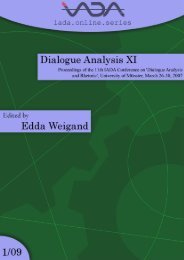Dialogue in and between Different Cultures - International ...
Dialogue in and between Different Cultures - International ...
Dialogue in and between Different Cultures - International ...
Create successful ePaper yourself
Turn your PDF publications into a flip-book with our unique Google optimized e-Paper software.
6 Jagdish Kaur<br />
In this extract, both participants produce a repeat of their prior turns after an<br />
<strong>in</strong>stance of overlapped talk. In l<strong>in</strong>e 4, V beg<strong>in</strong>s a new turn with the obvious<br />
<strong>in</strong>tention of summ<strong>in</strong>g up the discussion thus far <strong>and</strong> possibly mov<strong>in</strong>g on to<br />
another topic as <strong>in</strong>dicated by the turn <strong>in</strong>itial ‘so’ which, accord<strong>in</strong>g to Schiffr<strong>in</strong>,<br />
acts as “a marker of potential transition” (1987:227). However before V is able to<br />
complete his utterance, L beg<strong>in</strong>s his turn <strong>in</strong> l<strong>in</strong>e 5, result<strong>in</strong>g <strong>in</strong> a slight overlap.<br />
L’s move to repeat his utterance <strong>in</strong> its entirety is very likely prompted by the<br />
overlap. V who similarly appears to be orientat<strong>in</strong>g to the potential problem <strong>in</strong><br />
hear<strong>in</strong>g or underst<strong>and</strong><strong>in</strong>g that the overlap could engender repeats his still<strong>in</strong>complete<br />
turn as well (l<strong>in</strong>e 6). He however pushes the start of his turn a little too<br />
far up as a result of hav<strong>in</strong>g already projected the end of L’s repeat, result<strong>in</strong>g thus<br />
<strong>in</strong> a slight overlap.<br />
Example (4) below illustrates yet another <strong>in</strong>stance of repeat after overlap:<br />
(4) [T5/SA/C3-S(KOR):D(IND):T(THA)/93-101]<br />
01 S: yeah yeah yeah I’m go<strong>in</strong>g to talk about [that so huhhuhhuh er er so<br />
02 I-I-I found that people like to copy<br />
03 D: [huh<br />
04 uhhuh<br />
05 S: <strong>and</strong> copy<strong>in</strong>g is taken that it’s not a bad s<strong>in</strong>.<br />
06 D: uhhuh [uhhuh<br />
07 S: [I f<strong>in</strong>d as well they like [to copy<br />
08 D: [uhhuh uhhuh<br />
09 S: <strong>and</strong> I saw that this might [be the same th<strong>in</strong>g for students<br />
10 D: [like er photostat<strong>in</strong>g<br />
11 <strong>and</strong> then also we have to focus to the student<br />
12 S: → so yeah this might be the same th<strong>in</strong>g for the students<br />
13 D: a:::::h<br />
In the extract above, S (Korean) <strong>and</strong> D (Indonesian) are discuss<strong>in</strong>g the issue of<br />
plagiarism for a paper they have to jo<strong>in</strong>tly write. While S has been talk<strong>in</strong>g about<br />
plagiarism as committed by people <strong>in</strong> general, D has been try<strong>in</strong>g to get him to<br />
conf<strong>in</strong>e the discussion to plagiarism <strong>in</strong> the academic context. It appears that S is<br />
<strong>in</strong> fact try<strong>in</strong>g to draw similarities <strong>between</strong> the two as his segment of talk <strong>in</strong> l<strong>in</strong>e 9<br />
suggests. This segment of S’s turn however partially overlaps with D’s example<br />
of an act of plagiarism (as he sees it), i.e. ‘photostat<strong>in</strong>g’ (l<strong>in</strong>e 10). D’s utterance <strong>in</strong><br />
l<strong>in</strong>e 11, which reiterates an earlier call to focus on the academic context, clearly<br />
<strong>in</strong>dicates that S’s attempt to l<strong>in</strong>k plagiarism as committed by people generally to<br />
that committed by students (l<strong>in</strong>e 9) has been lost <strong>in</strong> the overlap. S addresses D’s<br />
display of non-hear<strong>in</strong>g <strong>and</strong>/or non-underst<strong>and</strong><strong>in</strong>g of his prior turn by produc<strong>in</strong>g a<br />
slightly modified repetition of it <strong>in</strong> l<strong>in</strong>e 12. This provides D with a second hear<strong>in</strong>g<br />
of that turn which appears to have the desired effect as reflected by his response<br />
<strong>in</strong> l<strong>in</strong>e 13. This example evidences the very real threat that overlap poses on the<br />
recipient’s hear<strong>in</strong>g <strong>and</strong> underst<strong>and</strong><strong>in</strong>g of talk that is produced <strong>in</strong> overlap.



